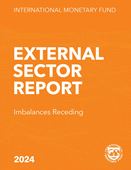External Sector Reports
2024
July 12, 2024
2024 External Sector Report: Imbalances Receding
Description:
Imbalances Receding This year’s report provides the external sector assessment of 30 of the world’s largest economies on the basis of their 2023 data. With tight monetary policy conditions in key advanced economies continuing in 2023, the US dollar remained strong in 2023 and early 2024 by historical standards, while other reserve currency movements have been mixed. Net capital inflows to emerging market and developing economies recovered slightly from the lows experienced in 2022 but remained negative in 2023. Gross inflows and outflows in emerging markets declined, however. Against this background, the global current account balance (defined as the cross-country sum of absolute values of current account) narrowed significantly in 2023, while the excess global current account balance (in excess of the current account norms) has remained broadly unchanged relative to 2022.
2023
July 19, 2023
2023 External Sector Report: External Rebalancing in Turbulent Times
Description: Amid the war, pandemic, and US monetary tightening, excess imbalances have not narrowed in 2022, while the US dollar appreciated significantly. Historically, financially driven dollar appreciation had negative spillovers, which could be alleviated by flexible exchange rates.
2022
August 4, 2022
Pandemic, War, and Global Imbalances | 2022 IMF External Sector Report
Description: Global current account balances—the overall size of current account deficits and surpluses—continued to widen in 2021 to 3.5 percent of world GDP, and are expected to widen again this year. The IMF’s multilateral approach suggests that global excess balances narrowed to 0.9 percent of world GDP in 2021 compared with 1.2 percent of world GDP in 2020.
2021
August 2, 2021
2021 External Sector Report: Divergent Recoveries and Global Imbalances
Description: Overall current account deficits and surpluses widened in 2020 to 3.2 percent of world GDP. The IMF’s multilateral approach suggests that global excessive imbalances were broadly unchanged in 2020 at about 1.2 percent of world GDP. The external outlook for2021 is highly uncertain given the divergent economic prospects across countries.
2020
August 4, 2020
2020 External Sector Report: Global Imbalances and the COVID-19 Crisis
Description: The IMF's 2020 External Sector Report finds that overall current account deficits and surpluses narrowed modestly in 2019 to just under 3 percent of world GDP. The IMF’s multilateral approach suggests that about 40 percent of overall current account deficits and surpluses were excessive in 2019. The external outlook for 2020 is subject to high uncertainty and cross-country variation.
2019
July 3, 2019
2019 External Sector Report: The Dynamics of External Adjustment
Description: After narrowing sharply in the aftermath of the global financial crisis, overall current account surpluses and deficits reached 3 percent of world GDP in 2018, declining marginally while rotating toward advanced economies in recent years. The IMF’s multilateral approach suggests that about 35–45 percent of overall current account surpluses and deficits were deemed excessive in 2018.
2018
July 19, 2018
2018 External Sector Report: Tackling Global Imbalances amid Rising Trade Tensions
Description: The IMF’s 2018 ESR shows that global current account balances stand at about 3¼ percent of global GDP. Of this, 40-50 percent are now deemed excessive, i.e. some countries are saving too much, and others are borrowing too much. And while global imbalances remain broadly unchanged in recent years, they have become increasingly concentrated in advanced economies.



